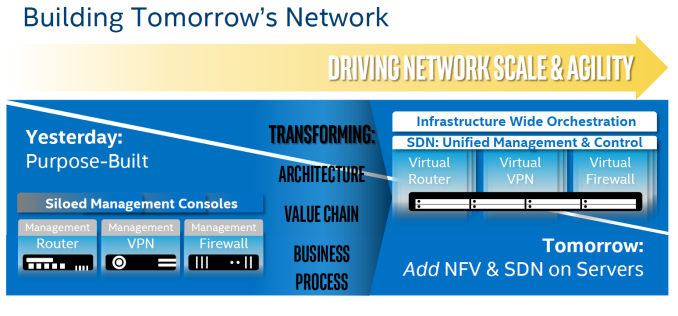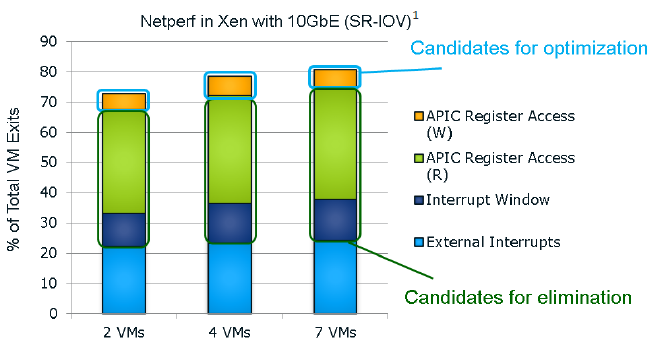The Intel Xeon E5 v4 Review: Testing Broadwell-EP With Demanding Server Workloads
by Johan De Gelas on March 31, 2016 12:30 PM EST- Posted in
- CPUs
- Intel
- Xeon
- Enterprise
- Enterprise CPUs
- Broadwell
TSX
TSX or Transactional Synchronization Extensions is Intel's cache-based transactional memory system. Intel launched TSX with Haswell, but a bug threw a spanner in the works. Broadwell in turn got it right. The chicken is finally there, now it's time to enjoy the eggs.
Faster Virtualization
Virtualization overhead is (for most people) a thing of the past. The performance overhead with bare metal hypervisors (ESXi, Hyper-V, Xen, KVM..) is less than a few percent. There is one exception however: applications where I/O dominates. And of course, the packet switching telco applications are the prime examples. Intel, VMware and the server vendors really want to convert the telcos from their Firewall/Router/VPN "black boxes" to virtual ones using Software Defined Networking (SDN) infrastructure. To that end, Intel has continued to work on reducing the virtualization performance overhead. Virtualization overhead can be described as the number of VM exits (VM stops and hypervisor takes over) times the VM exit latency. In IO intensive application, VM exits happen frequently, which in turn leads to hard to predict and high IO latency, exactly what the telco people hate.
Intel wants to conquer the telco's datacenter by turning it into a SDN
So Intel worked on both factors. So Broadwell-DP VM exit latency is once again reduced from 500 cycles to 400.
It seems that the "ticks" also get a VM exit reduction. This slide of the Ivy Bride EP presentation gives you a very good overview of the VM exits in a network intensive application; in this case a networkd bandwidth benchmark application.
I quote from our Ivy Bridge-EP review:
The Ivy Bridge core is now capable of eliminating the VMexits due to "internal" interrupts, interrupts that originate from within the guest OS (for example inter-vCPU interrupts and timers). The virtual processor will then need to access the APIC registers, which will require a VMexit. Apparently, the current Virtual Machine Monitors do not handle this very well, as they need somewhere between 2000 to 7000 cycles per exit, which is high compared to other exits.
The solution is the Advanced Programmable Interrupt Controller virtualization (APICv). The new Xeon has microcode that can be read by the Guest OS without any VMexit, though writing still causes an exit. Some tests inside the Intel labs show up to 10% better performance.
In summary, Intel eliminated the green and dark blue components of the VM exit overhead with APICv. Broadwell now takes on the VM exits due to the external interrupts.
The technology on Broadwell-EP to do this is called posted interrupt. Essentially, posted interrupts enables direct interrupt delivery to the virtual machine without incurring a VM exit, courtesy of an interrupt remapping table. It is very similar to VT-D, which allowed DMA remapping thanks to the physical to virtual memory mapping table. Telco applications - among others - are very latency sensitive. Intel's Edwin Verplancke gave us one such example: before posted interrupts, a telco application had a latency varying from 4 to 47 (!) µsec, depending on the load. Posted interrupts made this a lot less variable, and latency varied from 2.4 to 5.2 µsecs.
As far as we are aware, KVM and Xen seem to have already implemented support for posted interrupts.













112 Comments
View All Comments
PowerOfFacts - Thursday, June 23, 2016 - link
And now Oracle marketing speaks. Their HammerDB results are bogus. Oracle continues to site socket results when the majority of the world has moved on to per core results. They cite the results from a 32 core HammerDB then compare it to a 1 chip (1/2 of 1 socket) POWER8 because Phil has a hard-on for how "HE" believes IBM has packaged the processor and similarly chooses an Intel configuration to ensure "THEY" get the result they want. Phil & Oracle (appear) to always speak with forked tongue.patrickjp93 - Sunday, April 3, 2016 - link
"Best" only at specific scale-up workloads. There's a reason Sparc is not particularly popular for clusters and supercomputing (and it's NOT software compatibility). It sucks at a lot of workloads when compared to x86. As for the SAP benchmarks, that's to be expected since x86 doesn't yet support transactional memories. That changes with Skylake Purley though.Brutalizer - Wednesday, April 6, 2016 - link
In these 25ish benchmarks, the SPARC M7 is 2-3x faster on all kinds of workloads, not just some specific scale up workloads. The reason SPARC M7 is not popular for clusters (supercomputers are clusters) is not because of low raw compute performance, it is because of cost and wattage. The M7 is much more expensive than x86, and draws much more power. I guess somewhere 250 watt or so? M7 are in big enterprise servers, some have water cooling, etc. Whereas clusters have many cheap nodes, with no water cooling.Clusters can have x86 because the highest wattage x86 cpu, uses 140 watt or so. Not more. So it would be feasible to use 140 watt cpus in clusters. But not 250 watt cpus, they draw too much power.
For instance, the IBM Blue Gene supercomputer that hold spot nr 5 in top500 for a couple of years, used 850 MHz powerpc cpus, when everyone else used 2.4 GHz x86 or so. The 850 MHz cpu dont use lot of power, so that is the reason it was used in Blue Gene, not because it was faster (it wasnt). A large supercomputer can draw 10 MegaWatt, and that costs very much. Power is a huge issue in super computers. SPARC M7 draws too much power to be useful in a large cluster, and costs too much.
If we talk about raw compute power for SPARC M7, it reaches 1200 SPECint2006, whereas E5-2699v3 reaches 715 SPECint2006. Not really 2-3x faster, but still much faster.
In SPECfp2006, the M7 reaches 832, whereas the E5-2699v3 reach 474.
https://blogs.oracle.com/BestPerf/entry/201510_spe...
So, as you can see yourself, the SPARC M7 is faster on scale-up business workloads (it was designed for that type of workloads) and also faster on raw compute power. And faster in everything in between. Just look at the wide diversity among these 25 ish benchmarks.
Brutalizer - Wednesday, April 6, 2016 - link
BTW, do you really expect a 150 watt x86 cpu, to outperform a 250 watt SPARC M7 cpu? Have you seen benchmarks where they compare 250 watt graphics card vs a 150 watt graphics card? Which GPU do you think is faster? Do you expect a 150 watt GPU to outperform a 250 watt gpu?The SPARC M7 has 50% more cores, twice the cpu cache, twice the GHz, twice the Wattage, twice the RAM bandwidth, twice the nr of transistors (10 billions) - and you are surprised it is 2-3x faster than x86?
BTW, the SPARC M7 has stronger cores than x86. If you look at all these benchmarks, typically one M7 with 32 cores, is faster than two E5-2699v3 with 2x18 = 36 cores. This must mean that one SPARC M7 core, packs more punch than a E5-2699v3 core, because 32 SPARC cores are faster than 36 x86 cores in all benchmarks.
adamod - Friday, June 3, 2016 - link
i know this is an old post but i am confused (this isnt something i have learned much about yet) i am hoping you can help some...if the sparc has 2 to 3x performance and is 250w compared to 140w then wouldnt that make it MORE efficient? and if you need two 2699's to compare to a sparc m7 then wouldnt that be 280w, more than the 250w of the xeons? i realize there are other factors here but this doesnt make sense to me. also yea there are graphics cards that are a lower wattage and perform better...i am an AMD fan but nvidia has had some faster cards with better performance in the past...i have an R9 280X, a mid grade card rated at i believe 225w, kinda crazy when it can get beaten by 17w nvidia cardstqth - Sunday, April 3, 2016 - link
The SPARC and POWER servers are for people with unlimited pocket where compactness and reliability worth the premium it's spent on. If you have to ask how much it costs, you'd probably can't afford it.Xeons are commodity hardware where you could purchase the best bang for your buck.
They are not aiming at the same market. Most software wouldn't even work on both system.
Besides, benchmarks are worthless - unless the performance of the specific software is tested. And that's rare.
PowerOfFacts - Thursday, June 23, 2016 - link
Depends on which Xeon processors you are referring to. The latest Broadwell EP & EX chips can cost over $7K each. Well on par if not exceeding POWER8 chips and definitely more than OpenPOWER chips. Times are changing. Intel has milked their clients for a long time feeding them the marketing line of open, commodity & low cost. They are no longer open buying up ecosystem integrating into the silicone, what exactly does commodity mean anyway and as low cost goes ... as I just said, pretty salty.yuhong - Thursday, March 31, 2016 - link
64GB LR-DIMMs will probably not come out at reasonable prices until 8Gbit DDR4 is more mainstream.iwod - Thursday, March 31, 2016 - link
I thought Samsung announced a 128GB DIMM with some type of 3D / TSV RAM.Casper42 - Thursday, March 31, 2016 - link
Not shipping just yet though.Should be sometime this year though.